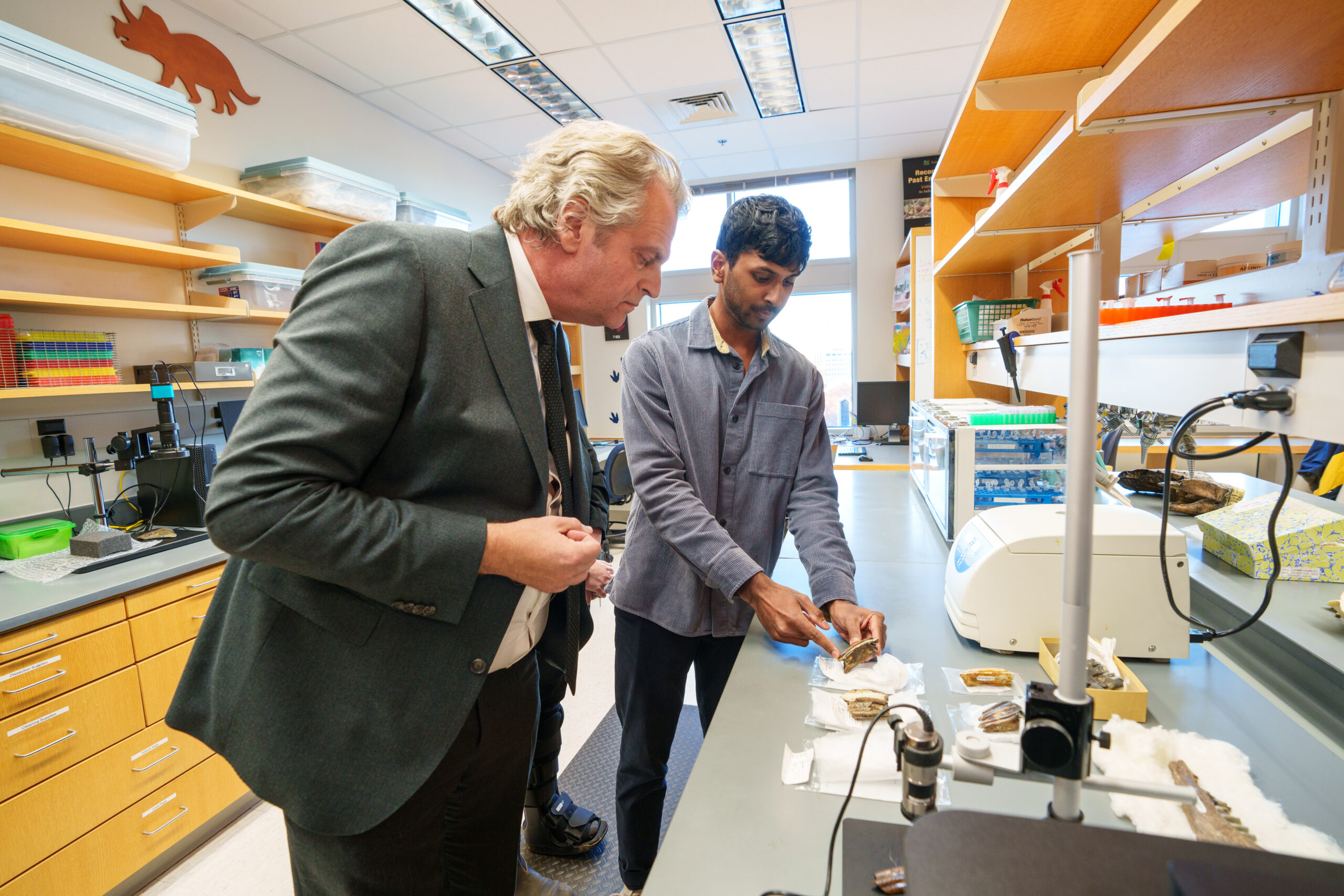Chancellor Diermeier visits the Evolutionary Studies Initiative
By Andy Flick, Evolutionary Studies scientific coordinator

On January 17, 2024, the Evolutionary Studies Initiative (ESI) was honored to receive a visit from Chancellor Daniel Diermeier. Chancellor Diermeier’s visit included an introduction to ESI’s mission and the research of select members, an open-ended discussion on investing in the future of evolutionary studies at Vanderbilt, and a tour of the DREAM Lab, the paleontological lab run by Larisa DeSantis, associate professor of biological sciences and Earth and environmental sciences.
Chancellor Diermeier was impressed with the initiative and the important research efforts of its investigators, noting that “this is a great initiative, and we want to support it.”
The meeting opened with Antonis Rokas, director of the Evolutionary Studies Initiative, welcoming the chancellor and providing a brief overview of the initiative’s mission and growth. “The story of our initiative is emblematic of our university’s Dare to Grow motto,” said Rokas.
Established in 2019, the Evolutionary Studies Initiative runs numerous highly successful research, educational, and outreach activities that unite scholars of evolution and/or its applications across our campus.

ESI members presented a brief overview of their activities and research programs, responding to probing questions from the chancellor. The discussion with the chancellor highlighted the breadth, diversity, and global reach of research from ESI faculty. Through field work across the globe and collaborations with an international network of researchers, ESI investigators’ research uses evolutionary approaches to tackle major health (e.g., drug resistance, evolution of disease), societal (e.g., climate change), and economic (e.g., livestock improvement and environmental management) challenges.
The open-ended discussion focused on actions that would further increase ESI’s footprint on the global stage, such as faculty retention and recruitment, the creation of an “evolution corridor” that would house the headquarters of ESI and the laboratories of several ESI investigators, and partnering with the university’s Communications and Marketing team to increase the visibility of ESI work and organize high-profile events on topics related to evolution and society.

The visit concluded with the chancellor’s tour of the ESI space and the DeSantis DREAM Lab. First on the tour were some of the teaching materials that ESI uses for its outreach programs, such as numerous hominid (human-like primates) fossil skull casts and a cast of a coelacanth (a deep sea “living fossil”). Then, DeSantis introduced the chancellor to four of her star undergraduate researchers, Sola Johnson (’24, Biochemistry), Adi Kurre (‘25, pre-dental, BSCI), Sabrina Wang (’26, EES), and Kirsten Kohler (’24, EEOB). Johnson and Kurre showed the chancellor examples of giant sloth teeth and ancient camels that lived in North America, magnified on the big screen to show off the horizontal striations and enamel sampling methods that help us understand the diets and ancient climates of these long extinct animals. By studying the teeth of animals still-living, like the three-toed sloth, we can understand the processes that led to the patterns we see in extinct animal teeth, like that of the giant ground sloth. Wang and Kohler continued the tour in the confocal lab where DREAM lab members examine the microscopic wear patterns on the teeth of a diversity of mammals across the globe, including the leopard teeth Kohler showcased under the microscope.
Thirteen faculty members from across the university attended the meeting: Megan Behringer, Jada Benn Torres, Ken Catania, Gianni Castiglione, Nicole Creanza, DeSantis, Paul Durst, Owen Jones, Lin Meng, Rokas, Carlos Taboada, Ann Tate, and Allison Walker. They represented six different departments (Anthropology, Biological Sciences, Chemistry, Communication of Science and Technology, Earth and Environmental Sciences, Law) and two schools (Arts & Science and Law), underscoring the interdisciplinary nature of the initiative. Also in attendance were Audrey Arner, a graduate student in the biological sciences graduate program and chair of the Evolution at Vanderbilt Organization for Students and Trainees (EVOST) and Dr. Andy Flick, scientific coordinator of ESI.